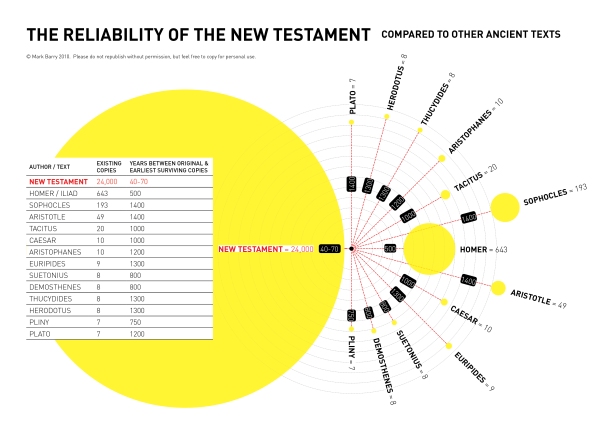Graphic: NT Reliability Comparison to Ancient Documents
Question:
This image has often been used to demonstrate the reliability of the New Testament. What is your response to this?

Answer:
This infographic relies on two of the three defective principles that beginners make when it comes to textual criticism, namely the number of witnesses (manuscripts) and the age of the witness (manuscripts). I’ve previously written on these three defective principles as outlined by the textual critical scholar Leon Vaganay. Before we get into the textual critical problems with this infographic, we first need to examine the theological problems with it.
Theology
One of the first claims we normally associate with the use of this infographic bases itself on the fallacy of false equivalency. We are told that scholars and historians have no problem trusting and relying on the ancient works ascribed to Homer, Aristotle or Plato, so given that we have so many more manuscripts of the New Testament we should have even more trust and reliance on the New Testament as it compares to the quantity of manuscripts for the previously aforementioned ancient documents. The problem with this argument is that I don’t need the works of Homer, Aristotle or Plato for salvation. Rejecting, not reading, ignoring and discarding the works of those men does not affect my salvation, which is why we can generally rely on and trust them. Since whether or not they actually are reliable or accurate does not affect my life in any meaningful way.
However, when it comes to the New Testament, it’s a different story. We are told it contains the inspired words of God, that we need to rely and trust it for our eternal salvation, that denying and rejecting it would lead to our eternal damnation. The stakes here are quite higher. Rejecting the works of Tacitus does not send me to hell. Waking up one morning to find out that alterations were made to the writings attributed to Plato, has no consequence on me whatsoever. My entire worldview does not change, my salvation does not rest on my accepting or rejecting the works of Tacitus and Plato. Therefore, when it comes to theology, it is an honestly poor argument to make that if we can trust something that has no bearing on our salvation, then we can also trust something that allegedly has significant bearing on our salvation. This is a dishonest comparison by all means.
The Number
There are some 24, 000 manuscripts! That number is practically meaningless and useless for a number of reasons. To begin with, of the 24, 000 that this infographic claims exists, how many of them are within the first 300 years of Christianity? According to the Institute for New Testament Textual Research (INTF) there are only 67 manuscripts in total existing from this time period. That figure represents 0.27% of the total number of New Testament manuscripts. The vast majority of New Testament manuscripts were written after the 11th century CE, some 1100 years after the Messiah. So while the number is big, it is misleading.
The Date
The number is misleading because it is juxtaposed with the date range of 40-70 years “between the earliest surviving copies”. Seeing 24, 000 juxtaposed with an early date range is extremely misleading, leaving the impression that the number correlates with the date range. In reality, there are only 7 New Testament manuscripts that fall into the first 200 years of Christianity, all of which are extremely fragmentary. That represents a figure of 0.029% of all New Testament manuscripts that can possibly be ascribed to the date range given in the infographic.
Conclusion
While the infographic does provide somewhat accurate information, its use of that information to argue for the reliability of the New Testament is both misleading and dishonest. The arguments derived from the use of this infographic don’t endorse the claim of the reliability of the New Testament, but rather demonstrates that many Christians simply do consider their scripture to be equal in weight to the works of ancient peoples. The very fact that they choose to argue that if we can trust the ancient manuscripts ascribed to Plato and Homer, therefore we can trust the New Testament is to also say that Plato’s and Homer’s work stand on the same credibility level as that of scripture inspired by God. Rather than defend the holiness of scripture, such an argument truthfully undermines it, while falsely comparing what should be the work inspired by a holy and all knowing God, to that of mortal men.
and God knows best.

Very nice article masha Allah.
I wonder if the writer knows of any videos that talk about the thousands of people who subscribed to the NT?
I have written many good articles related to this subject of manuscripts. Please check them out:
https://islamicarchives.wordpress.com/2017/05/30/p52-vs-birmingham-manuscript-comparing-the-earliest-biblical-manuscript-to-the-earliest-quranic-manuscript/
https://islamicarchives.wordpress.com/2017/05/22/25000-new-testament-manuscripts-big-deal/
https://islamicarchives.wordpress.com/2017/11/06/its-been-more-than-five-years-where-is-this-first-century-fragment-of-mark/
https://islamicarchives.wordpress.com/2017/06/06/91-7-of-the-quran-in-first-century-ah-vs-0-of-the-bible-in-first-century-ad/
https://islamicarchives.wordpress.com/2017/05/30/the-quran-is-radio-carbon-dated-why-not-the-bible-also-a-short-examination-of-paleography/
https://islamicarchives.wordpress.com/2017/05/25/can-the-new-testament-be-reconstructed-from-the-writings-of-the-church-fathers-muslims-answer/
https://islamicarchives.wordpress.com/2017/05/16/can-we-really-restore-the-original-new-testament-through-patristic-citations/
Br. Ijaz, if you could comment on this post I would appreciate it:
https://islamicarchives.wordpress.com/2017/06/06/91-7-of-the-quran-in-first-century-ah-vs-0-of-the-bible-in-first-century-ad/
Sorry, one last comment on this post: